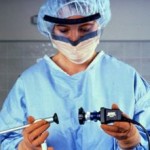Laparoscopy procedure
What is a laparoscopy procedure?
 A gynaecological laparoscopy procedure is used to view inside the abdomen and stomach, commonly used to investigate the ovaries, womb and fallopian tubes. A laparoscopy is a camera which is attached to a telescope, a small incision is made and the instrument is inserted. The surgeon can then easily see all the internal organs, pictures which will be sent to a television screen, so the images can be magnified and studied.
A gynaecological laparoscopy procedure is used to view inside the abdomen and stomach, commonly used to investigate the ovaries, womb and fallopian tubes. A laparoscopy is a camera which is attached to a telescope, a small incision is made and the instrument is inserted. The surgeon can then easily see all the internal organs, pictures which will be sent to a television screen, so the images can be magnified and studied.
In order to create a space in the abdomen during the laparoscopy procedure carbon dioxide will be pumped through a channel. The Laparoscopy procedure is usually carried out using general anaesthetic to help control any discomfort. The incision made in order to carry this out is usually only 1-2cm, usually just below the belly button.
Laparoscopy procedure overview
The Laparoscopy surgery usually takes around fifteen minutes, this can depend on which type of treatment is required. The surgeon will begin by making an incision just below the belly button, a tube will be inserted and gas pumped in to expand the abdomen so the surgeon can see better. The Laparoscopy will then be used to view all your organ such as ovaries, fallopian tube and womb. If any treatment is needed, the surgeon can insert any instrument needed through the incision already made. Once the procedure is completed the surgeon will let the gas out via the Laparoscopy, and the cut will be stitched.
Sometimes the surgeon may need to use coloured dye, this can be administered through the cervix into the womb and the fallopian tubes. During the Laparoscopy procedure the surgeon is able to see any blockage in the fallopian tubes.
Why the Laparoscopy procedure maybe used
Suspected endometriosis it can be used to make the diagnosis or even for treatment Pelvic inflammatory disease-this is an inflammation in the ovaries, womb or the fallopian tubes. Laparoscope surgery can be used to diagnose the problem and carry out required treatment. Adhesions- removal of scar tissue
Treatment from an ectopic pregnancy
Sterilisation in woman
Ovarian cyst - They can be removed during Laparoscopy procedure
Fibroids - these are non cancerous growths that can develop either inside or outside the womb Removal of lymph nodes
After a Laparoscopy procedure
There is some temporary side affects which may cause discomfort most usually start to feel better with in 48 hours. Some of the side affects after the Laparoscopy procedure include:
Pain in the shoulders- this is usually cased by the gas inserted to inflate the abdomen. Pain in the abdomen
bruising on the abdomen or surrounding areas
Paracetamol and other over the counter painkillers may be used to keep the pain under control after Laparoscopy procedure has been carried out.
|